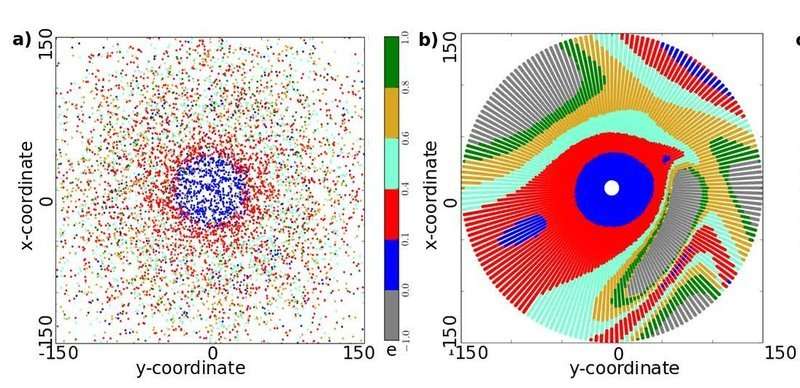Impact of a stellar intruder on our solar system

The solar system was formed from a protoplanetary disk consisting of gas and dust. Since the cumulative mass of all objects beyond Neptune is much smaller than expected and the bodies there mostly have inclined, eccentric orbits, it is likely that some process restructured the outer solar system after its formation. Susanne Pfalzner from the Max Planck Institute for Radio Astronomy in Bonn, Germany, and her colleagues present a study showing that a close fly-by of a neighbouring star can simultaneously lead to the observed lower mass density in the outer part of the solar system and excite the bodies there onto eccentric, inclined orbits. Their numerical simulations show that many additional bodies at high inclinations still await discovery, perhaps including the sometimes postulated "planet X."
The findings are published in the Astrophysical Journal.
A near catastrophe billions of years ago might have shaped the outer parts of the solar system, while leaving the inner regions basically untouched. Researchers from the Max Planck Institute for Radio Astronomy in Bonn and their collaborators found that a close fly-by of another star can explain many of the features observed in the outer solar system. "Our group has been looking for years at what fly-bys can do to other planetary systems, never considering that we actually might live right in such a system," says Susanne Pfalzner, the lead author of the project. "The beauty of this model lies in its simplicity."
The basic scenario of the formation of the solar system has long been known: The sun was born from a collapsing cloud of gas and dust. In the process, a flat disk was formed in which large planets grew, along with smaller objects like the asteroids, dwarf planets, etc. Due to the flatness of the disk, the planets would be expected to orbit in a single plane unless something dramatic happened. Looking at the solar system right to the orbit of Neptune, everything seems fine: Most planets move on fairly circular orbits and their orbital inclinations vary only slightly. However, beyond Neptune, things become very messy. The biggest puzzle is the dwarf planet Sedna, which moves on an inclined, highly eccentric orbit and is so far outside that it could not have been scattered by the planets there.
Just outside Neptune's orbit another strange thing happens. The cumulative mass of all the objects dramatically drops by almost three orders of magnitude. This happens at approximately the same distance where everything becomes messy. It might be coincidental, but such coincidences are rare in nature.
Susanne Pfalzner and her co-workers suggest that a star approached the sun at an early stage, stealing most of the outer material from the sun's protoplanetary disk and throwing what was left into inclined and eccentric orbits. Performing thousands of computer simulations, they checked what would happen when a star passes very closely and perturbs the once larger disk. It turned out that the best fit for today's outer solar systems comes from a perturbing star with the same mass as the sun or somewhat lighter (0.5-1 solar masses), which flew past at approximately three times the distance of Neptune.
However, the most surprising finding was that a fly-by does not only explain the strange orbits of the objects of the outer solar system, but also gives a natural explanation for several other unexplained features of the solar system, including the mass ratio between Neptune and Uranus, and the existence of two distinct populations of Kuiper Belt objects.
"It is important to keep exploring all the possible avenues for explaining the structure of the outer solar system. The data are increasing, but still too sparse, so theories have a lot of wiggle room to develop," says Pedro Lacerda from the Queen's University in Belfast, a co-author of the paper. "There is a certain danger that one theory crystallises as truth not because it explains the data better, but because of other pressures. Our paper shows that a lot of what we currently know can be explained by something as simple as a stellar fly-by."
The big question is the likelihood for such an event. Today, fly-bys even hundreds of times more distant are fortunately rare. However, stars like our sun are typically born in large groups of stars that are much more densely packed. Therefore, close fly-bys were significantly more common in the distant past. Performing another type of simulation, the team found that there was a 20 to 30 percent chance of experiencing a fly-by over the first billion years of the sun's life.
This is no final proof that a stellar fly-by caused the messy features of the outer solar system, but it can reproduce many observations and seems relatively realistic. So far, it is the simplest explanation, and if simplicity is a marker of validity, this model is the best candidates so far.
"In summary, our close fly-by scenario offers a realistic alternative to present models suggested to explain the unexpected features of the outer solar system," concludes Susanne Pfalzner. "It should be considered as an option for shaping the outer solar system. The strength of the fly-by hypothesis lies in the explanation of several outer solar system features by one single mechanism."
More information: Outer solar system possibly shaped by a stellar fly-by. de.arxiv.org/abs/1807.02960
Journal information: Astrophysical Journal
Provided by Max Planck Society





















